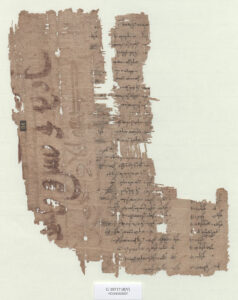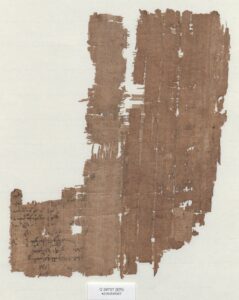A document as visually striking as it is fascinating for those of us interested in the (fiscal) administration of eighth-century Egypt, our document of the week certainly deserves more attention than it has received in the past. In these particular Tax Files, Eline Scheerlinck presents the document and notable elements from its history, from production to publication.

CPR III 136 (Arabic) = P.GrohmannProbleme 2 (Greek) = PERF 91 (description). Austrian National Library G39717. Recto.
The papyrus, part of the papyrus collection of the Austrian National Library in Vienna, presents two very clearly different blocks of text: one Arabic, painted in a brownish metal gall ink, in large letters, and one, at a 90-degree angle, written in Greek with a pen in black ink. The Greek text, a list recording names and amounts of money in rather neat rows and columns, also continues on the other side of the sheet. The presence of the Arabic text on this fragment of papyrus, which, with its size of approximately 30 x 24 cm, is a sizeable piece, denotes that to write this list, the scribe had used the very beginning of a fresh roll of papyrus. In fact, the Arabic preserves the end of a protocol text.

CPR III 136 (Arabic) = P.GrohmannProbleme 2 (Greek) = PERF 91 (description). Austrian National Library G39717. Verso.
A protocol text, from prōtokollon, which in Greek denotes the first sheet of a papyrus roll, indicates the authority under which the papyrus roll was produced. This information could include the name of the caliph as well as the current governor or financial director in Egypt, as well as the year and place of production. Here, three lines are visible, although from the first line only the bottom parts of some of the letters remain. The editor of the protocol text, Grohmann, who published it as CPR III 136 (1924), conjectures, on the basis of a partial reading of this line and the reading of the date in the second line, the name of Abu Ṣāliḥ, governor of Egypt at this time, i.e., the year 164 AH or 780/781 CE. So, the Arabic text of the protocol on the papyrus has been translated: Abu Ṣāliḥ / (year) 164/ Product of Phragonis. Phragonis, located in the Nile Delta, is mentioned as the place of production in 17 of the Arabic protocol texts edited by Grohmann CPR III.
After it was produced, the papyrus roll was used in an administrative office in the Fayyum, where a scribe recorded payments made by local taxpayers at some point in or after the year 780/781. While the protocol text was written in Arabic, the fiscal list was written fully in Greek. Karabacek, who first published a description of this document (as PERF 91), wondered: “Höchst merkwürdig ist, dass man sich in den ägyptischen Steuerkanzleien in so später Zeit noch hierbei der griechischen Schrift bediente.” In fact, the scribe of the fiscal list was actually a trilingual scribe, who can be seen practicing Arabic, Coptic, and Greek formulas and phrases in CPR XXII 17 (Morelli in his edition of CPR XXII 17 identifies the scribe, while Berkes and Younes in their article “A Trilingual Scribe from Abbasid Egypt? A note on CPR XXII 17” from 2012 show that the scribe of CPR XXII 17 is trilingual). The knowledge and use of Greek in the fiscal administration of early Abbasid Egypt has been receiving attention in recent scholarship, notably and most recently in the work of Lajos Berkes, as well as on this blog, as the multilingual aspect of the Abbasid fiscal administration is part of my research. While Karabacek gave a very short description of the document and its contents, a transcription of the Greek text is given by Grohmann in an installment of his “Probleme der arabischen Papyrusforschung” in 1936. This transcription is based on Karl Wessely’s reading, who had planned to publish the Greek text but died in 1931.
The list, which calls itself a kōdikon (register), presents several columns, with amounts of money recorded both to the right and to the left of a column of names of taxpayers. These amounts recorded are generally lower than 5 nomismata and present a high number of fractions. A column on the right of the recto, of which we only have the bottom part, recorded total amounts of the payments. Several smudges that seem to have a rather deliberate placement in the column or margin to the left of the names might indicate deletions or corrections of amounts recorded.
Greek and Coptic documents are cited according to the “Checklist of Editions of Greek, Latin, Demotic, and Coptic Papyri, Ostraca, and Tablets”. Arabic documents are cited according to “The Checklist of Arabic Documents”.
Banner Image: Free stacks of paper files image, public domain CC0 photo.
This post was written by Eline Scheerlinck.




Leave a Reply